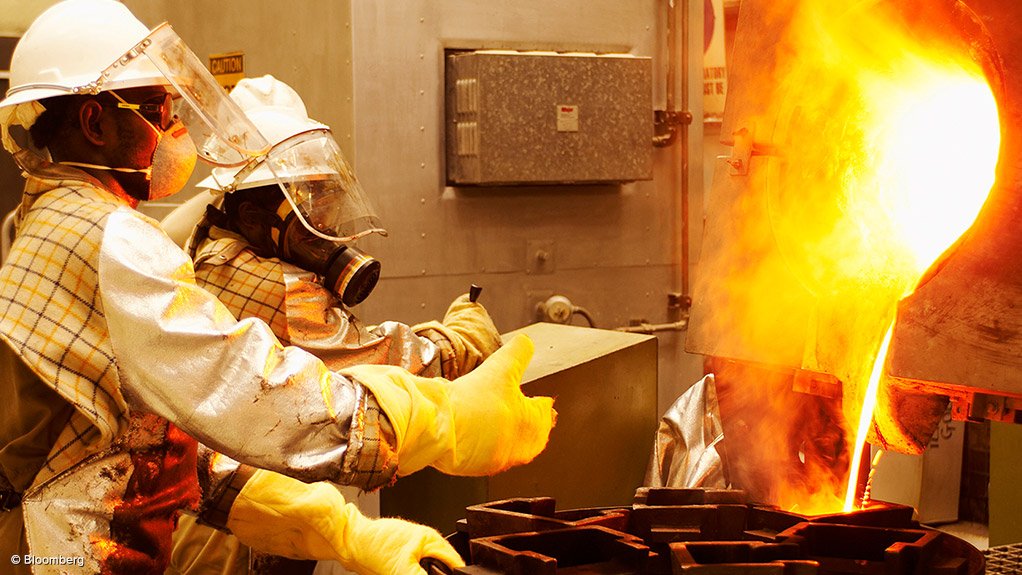Australia needs to double exploration efforts to maintain gold output
PERTH (miningweekly.com) – Gold production from the world’s second-largest producer of the precious metal, Australia, is expected to halve over the next four decades, as the number of operating mines is forecast to fall sharply.
A study by mining economists MinEx Consulting forecasts that Australia’s gold production will drop from the 9.7-million ounces in 2017, to 4.69-million ounces by 2057, cutting revenues by 50% to A$7.3-billion.
The study estimates that the number of operating mines is set to fall by one-third, from 71 to 47 and that total employment will decrease by 70%, from 27 980 to 8 300 workers.
In the report, sponsored by federal and state government agencies, MinEx notes that over the next five years, gold production in Australia will be dominated by existing mines, with output from these operations expected to remain steady over the next two years, after which it will start to decline.
Within 40 years, only four of the current 71 operating mines will still be operational, with most of the mines expected to close over the next two decades, including the Kalgoorlie Super Pit operation and the Telfer mine, both in Western Australia.
By 2057, the remaining mines will contribute only an estimated 400 000 oz/y of gold.
MinEx predicts that in the next five to ten years, an increasing amount of production will be supplied from new mines that will be based on known deposits. However, this new production will not be sufficient to offset the decline from existing mines, and by 2057, the new projects will generate only 300 000 oz/y.
Furthermore, MinEx points out that a number of these new projects will only be economic under high gold price scenarios.
Within 10 to 40 years, gold production will be based on exploration success, with MinEx forecasting that over the longer term, some A$677-million a year will be spent on gold exploration in Australia, which will likely result in the discovery of 266 new gold deposits being discovered over the next 40 years.
Only half of these deposits are likely to be developed, contributing 4.06-million ounces of gold in 2057. This is equal to 87% of the combined total production of 4.69-million ounces a year in that year.
Consequently, in 40 years' time almost all of Australia’s future gold production will come from exploration successes.
Author Richard Schodde points out that the model used in the study predicts that in 15 years' time, half of Australia’s gold production will come from mines that are yet to be discovered.
However, he noted that of serious concern is the fact that the weighted average delay between discovery and development for a new discovery is 13 years. There are also indications that it is getting harder and slower to convert a discovery into a mine.
“Consequently, government and industry need to support exploration today. We only have the next couple of years to properly identify and address ways to improve our exploration performance, otherwise Australia runs the real risk of a significant supply disruption in the medium term,” Schodde says.
Sensitivity studies indicate that each additional dollar spent on exploration generates an extra $11.40 in revenue.
MinEx estimates that for the Australian gold industry to maintain production at current levels in the longer term, it will either need to double the amount spent on exploration or double its discovery performance.
Schodde notes that the incremental benefits of reaching this target will be an extra 4.05-million ounces a year of production, an extra A$6.23-billion in revenues and an additional 7 160 jobs.
“The opportunity exists for industry and government to take the initiative to invent its own future. In addition to developing policies that encourage or stimulate exploration, the opportunity also exists to be more efficient and effective at making discoveries.
“The challenge is that many of these initiatives require effort and money, and will take several years to bear fruit,” he says.
Comments
Press Office
Announcements
What's On
Subscribe to improve your user experience...
Option 1 (equivalent of R125 a month):
Receive a weekly copy of Creamer Media's Engineering News & Mining Weekly magazine
(print copy for those in South Africa and e-magazine for those outside of South Africa)
Receive daily email newsletters
Access to full search results
Access archive of magazine back copies
Access to Projects in Progress
Access to ONE Research Report of your choice in PDF format
Option 2 (equivalent of R375 a month):
All benefits from Option 1
PLUS
Access to Creamer Media's Research Channel Africa for ALL Research Reports, in PDF format, on various industrial and mining sectors
including Electricity; Water; Energy Transition; Hydrogen; Roads, Rail and Ports; Coal; Gold; Platinum; Battery Metals; etc.
Already a subscriber?
Forgotten your password?
Receive weekly copy of Creamer Media's Engineering News & Mining Weekly magazine (print copy for those in South Africa and e-magazine for those outside of South Africa)
➕
Recieve daily email newsletters
➕
Access to full search results
➕
Access archive of magazine back copies
➕
Access to Projects in Progress
➕
Access to ONE Research Report of your choice in PDF format
RESEARCH CHANNEL AFRICA
R4500 (equivalent of R375 a month)
SUBSCRIBEAll benefits from Option 1
➕
Access to Creamer Media's Research Channel Africa for ALL Research Reports on various industrial and mining sectors, in PDF format, including on:
Electricity
➕
Water
➕
Energy Transition
➕
Hydrogen
➕
Roads, Rail and Ports
➕
Coal
➕
Gold
➕
Platinum
➕
Battery Metals
➕
etc.
Receive all benefits from Option 1 or Option 2 delivered to numerous people at your company
➕
Multiple User names and Passwords for simultaneous log-ins
➕
Intranet integration access to all in your organisation





















